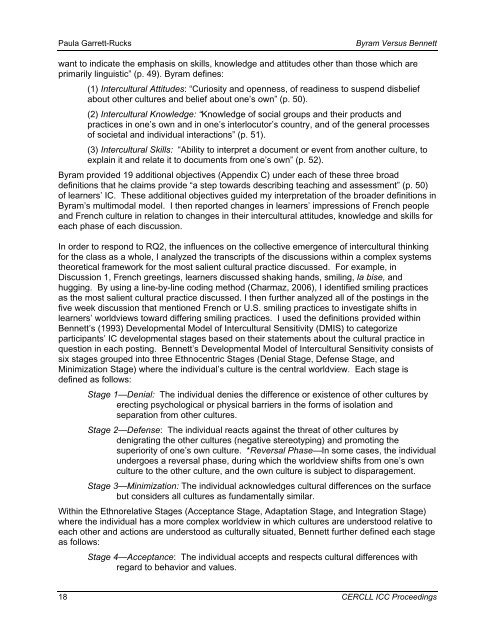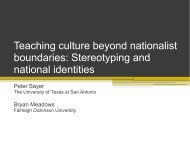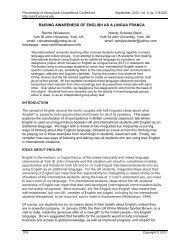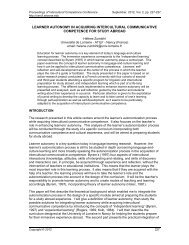BYRAM VERSUS BENNETT: DISCREPANCIES IN THE ... - CERCLL
BYRAM VERSUS BENNETT: DISCREPANCIES IN THE ... - CERCLL
BYRAM VERSUS BENNETT: DISCREPANCIES IN THE ... - CERCLL
You also want an ePaper? Increase the reach of your titles
YUMPU automatically turns print PDFs into web optimized ePapers that Google loves.
Paula Garrett-Rucks Byram Versus Bennett<br />
want to indicate the emphasis on skills, knowledge and attitudes other than those which are<br />
primarily linguistic” (p. 49). Byram defines:<br />
(1) Intercultural Attitudes: “Curiosity and openness, of readiness to suspend disbelief<br />
about other cultures and belief about one’s own” (p. 50).<br />
(2) Intercultural Knowledge: “Knowledge of social groups and their products and<br />
practices in one’s own and in one’s interlocutor’s country, and of the general processes<br />
of societal and individual interactions” (p. 51).<br />
(3) Intercultural Skills: “Ability to interpret a document or event from another culture, to<br />
explain it and relate it to documents from one’s own” (p. 52).<br />
Byram provided 19 additional objectives (Appendix C) under each of these three broad<br />
definitions that he claims provide “a step towards describing teaching and assessment” (p. 50)<br />
of learners’ IC. These additional objectives guided my interpretation of the broader definitions in<br />
Byram’s multimodal model. I then reported changes in learners’ impressions of French people<br />
and French culture in relation to changes in their intercultural attitudes, knowledge and skills for<br />
each phase of each discussion.<br />
In order to respond to RQ2, the influences on the collective emergence of intercultural thinking<br />
for the class as a whole, I analyzed the transcripts of the discussions within a complex systems<br />
theoretical framework for the most salient cultural practice discussed. For example, in<br />
Discussion 1, French greetings, learners discussed shaking hands, smiling, la bise, and<br />
hugging. By using a line-by-line coding method (Charmaz, 2006), I identified smiling practices<br />
as the most salient cultural practice discussed. I then further analyzed all of the postings in the<br />
five week discussion that mentioned French or U.S. smiling practices to investigate shifts in<br />
learners’ worldviews toward differing smiling practices. I used the definitions provided within<br />
Bennett’s (1993) Developmental Model of Intercultural Sensitivity (DMIS) to categorize<br />
participants’ IC developmental stages based on their statements about the cultural practice in<br />
question in each posting. Bennett’s Developmental Model of Intercultural Sensitivity consists of<br />
six stages grouped into three Ethnocentric Stages (Denial Stage, Defense Stage, and<br />
Minimization Stage) where the individual’s culture is the central worldview. Each stage is<br />
defined as follows:<br />
Stage 1—Denial: The individual denies the difference or existence of other cultures by<br />
erecting psychological or physical barriers in the forms of isolation and<br />
separation from other cultures.<br />
Stage 2—Defense: The individual reacts against the threat of other cultures by<br />
denigrating the other cultures (negative stereotyping) and promoting the<br />
superiority of one’s own culture. *Reversal Phase—In some cases, the individual<br />
undergoes a reversal phase, during which the worldview shifts from one’s own<br />
culture to the other culture, and the own culture is subject to disparagement.<br />
Stage 3—Minimization: The individual acknowledges cultural differences on the surface<br />
but considers all cultures as fundamentally similar.<br />
Within the Ethnorelative Stages (Acceptance Stage, Adaptation Stage, and Integration Stage)<br />
where the individual has a more complex worldview in which cultures are understood relative to<br />
each other and actions are understood as culturally situated, Bennett further defined each stage<br />
as follows:<br />
Stage 4—Acceptance: The individual accepts and respects cultural differences with<br />
regard to behavior and values.<br />
18 <strong>CERCLL</strong> ICC Proceedings





